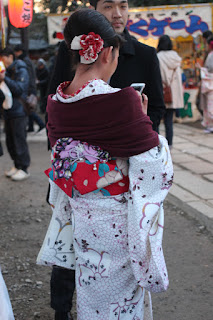W Japonii przestrzega się mocno kalendarza chińskiego, który rozpoczyna się na początku lutego. Ale nasz amerykańsko-europejski nowy rok również jest tam mocno zaznaczony, do tego stopnia, że Dżapońce wylegają na ulice w strojach tradycyjnych. Po prostu Japonia pragmatycznie połączyła te "dwa światy".
Although Japan firmly sticks to the Chinese calendar, the "western" new year in Kyoto was very festive as Japan has combined the two new years:). In the many temples celebrations were held and a lot of ladies were seen wearing kimonos.
Kyoto - druga chronologicznie stolica Japonii przez ponad 1000 lat (794-1868).
Dużo tam świątyń buddyjskich i pięknych ogrodów oraz dzielnica gejsz.
Poza tym jest to jedno z największych miast Nipponu.
Kyoto - the second capital city of Nippon for over 1000 years (794-1868). There are many buddhist temples there and also a Geisha District (will comment in next account).
W Nowy Rok jedna z najważniejszych buddyjskich świątyń pełna była ludzi. Odbywały się w niej jakieś uroczystości. I po całym terenie przewalały się tłumy, a między nimi piękne kwieciste kimona na młodych dziewczynach podczas gdy starsze osoby występowały w kolorach jesiennych :)
On New Year's Day 2016 one of major Buddhist temples was packed with people. Celebrations were held and many ladies attended wearing their flowered traditional attires. The elderly people, on the other hand, wore "autumn coloured" dresses.
 |
| Those in their life's autumn |
Na terenie świątyni było bardzo dużo pomocników świątynnych wskazujących drogę i udzielających informacji.
Around the temple there were many attendants dressed in special costumes who helped find the way or provided information.
 |
| Tak ubrane panienki żegnały ludzi wychodzących ze świątyni. / The girls in such clothes were saying "goodbye" to those leaving the temple |
Wychodząc ze świątyni trzeba było włożyć buty.
While leaving the temple, they had to put on their shoes.
 |
| Wejście do jednej z większych świątyń / The entrance to one of the biggest temples |
 |
| Modły przed świątynią/ Prayers in front of the temple |
 |
| The characteristic lamps |
 |
| Ofiara wrzucana do wielkiej skrzyni z odległości / The congregation were throwing coins into a big chest from a distance |
 |
| Dekoracja odświętna/ A festive decoration |
 |
| Strażnik w odświętnych skarpetkach / The guardian wearing festive socks :) |
 |
| Ognisko świątynne/ A temple bonfire |
 |
| Lampiony i karteczki z życzeniami/ Lamps and wish papers |
 |
| Już czai się Małpa - zaczyna swoje panowanie 8 lutego 2016 / The Monkey is getting ready for the beginning of the Chinese Year on 8th February 2016. |
Wokoło świątyń pełno straganów z jadełkiem.
The temples are a perfect place to sell food...
 |
| Silikonowe zielone bułeczki (patrz - Nara) / "Silicon" green buns (rice flour pastry and green tea) |
 |
| Za 250 jenów można było zjeść kręconego kartofla :) / A winding fried potato for 250 yen |
 |
| W Dżaponii lepiej posługiwać się ich językiem (zresztą w Korei też ) :) / In Japan English is not at its best :) |
 |
| Ho, ho - "elitarne" ośmiorniczki trafiły pod strzechy, tzn. na stargany :) / Octopus impaled and fried |
 |
| Kiełbasa dłuższa niż dziecko / The sausage is longer than the baby |
 |
| Słodycze/ Sweets |
Na ulicach i na dworcu też kimona chodziły w dużych ilościach.
The Kimonos were everywhere- the streets, the station, the shops
:)




















































